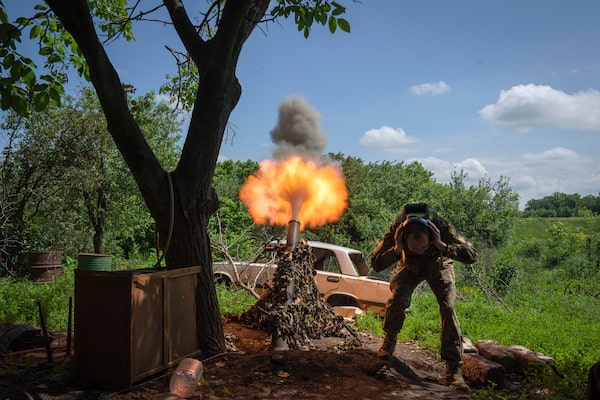
A Ukrainian soldier fires a mortar at Russian positions on the frontline near Bakhmut, Donetsk region, Ukraine on May 29, 2023.Efrem Lukatsky/The Associated Press
Ukraine’s Foreign Affairs Minister has called on the international community to not allow air attacks on Ukrainian cities to become routine, after Russia launched three barrages of missiles and drones at Kyiv and other centres in a 36-hour period.
“Russia’s drone and missile attacks on peaceful Ukrainian cities can not be seen as usual, no matter how frequent they grow,” Dmytro Kuleba wrote on Twitter as air-raid sirens, followed by a series of loud explosions, resounded across the capital for the second time in a matter of hours Monday morning. “They are all war crimes and must be stopped by further strengthening Ukraine’s air defence, including with F-16s, and defeating Russian aggression as such.”
Russia fired 140 missiles and drones at Ukrainian cities Sunday and Monday – including 75 cruise missiles and drones just before dawn Monday, with a secondary attack involving 11 ground-launched ballistic missiles just six hours later – according to a count by the Ukrainian Air Force. The vast majority of the projectiles were fired at Kyiv, and almost all of them were destroyed by the capital’s advanced air defences, which include a Patriot anti-missile battery donated by the U.S.
A fourth wave of attacks began early Tuesday morning local time, with air-raid sirens followed by the sounds of dozens of Iranian-made Shahed drones. Kyiv Mayor Vitaliy Klitschko called the new attack “massive” and said several fires had broken out in the city as a result of falling debris.
While Ukrainians have grown accustomed to sheltering in their homes during overnight barrages – of which there have been 16 in May alone – Monday’s daytime attack saw Kyiv residents crowding into the city’s network of deep subway stations, which are converted into bomb shelters during air attacks. In one video posted to social media, schoolchildren in the Podil neighbourhood could be seen screaming and running with their backpacks as explosions were heard overhead.
Ukrainian President Volodymyr Zelensky was among those who shared the video via his Telegram account. “Ukrainian children. Every time an air raid alert sounds. This is what an ordinary weekday looks like,” he wrote. “Thank you to everyone in the world who helps protect people and our children from Russian terror!”
With Kyiv’s air defences intercepting all 11 of the Iskander missiles fired at the capital in the second round Monday, the biggest danger for residents was falling pieces of burning debris. A video posted to Telegram by Ukrainian journalist Andriy Tsaplienko captured part of a flaming rocket plummeting onto a highway between two moving cars, narrowly missing them both, as well as a passing cyclist.
Kyiv Mayor Vitaly Klitschko said missile parts had fallen in three parts of the city and that one person had been injured.
Ukrainian Air Force spokesman Yurii Ihnat said the Iskander missiles had been fired from north of Kyiv, without clarifying if he meant Russian territory – which is about 380 kilometres northeast of the Ukrainian capital – or that of Russian ally Belarus, which is directly to the north. Iskanders have a range of about 500 kilometres.
During the larger, predawn attack, some Russian missiles did manage to penetrate Ukrainian defences. At least one cruise missile struck a Ukrainian air base in the Khmelnitsky region, in the west of the country, damaging a runway and reportedly putting five aircraft out of action.
In the central Dnipropetrovsk region, a woman was killed and nine people were injured when two houses were destroyed in the town of Pokrovske. Separately, a fire erupted in the Black Sea port of Odesa, which is crucial to Ukraine’s efforts to export grain.
Shelling was also reported along much of the front line that stretches through the provinces of Donetsk, Luhansk, Zaporizhzhia and Kherson, all of which are under partial Russian occupation. The series of Russian air attacks comes as both sides are preparing for a long-anticipated Ukrainian counteroffensive aimed at liberating the occupied areas.
Fifteen months after Russian President Vladimir Putin launched what was expected to be a rapid invasion of Ukraine, the fighting has started to cross the border into Russia itself. On Monday, Vyacheslav Gladkov, the Governor of the Belgorod region, said four people had been injured by artillery fire from the Ukrainian side of the border. Last week, two units of Russian citizens fighting for Ukraine briefly crossed into Belgorod, taking control of several small settlements.
Mr. Gladkov was quoted by Kremlin-controlled media saying that his region would only be secure if Russia annexed the neighbouring Kharkiv province of Ukraine. Russian troops entered Kharkiv en masse at the start of the war but were driven out of the area by a major Ukrainian counterattack last fall.
Mykhailo Podolyak, a top aide to Mr. Zelensky, said Monday that it was Ukraine that needed security guarantees. Writing on Twitter, he said a demilitarized zone “of 100-120 kilometres” should be established on the Russian side of the border as part of any agreement to end the war. The zone, he said, should be patrolled by an “international control contingent.”
 Mark MacKinnon
Mark MacKinnon